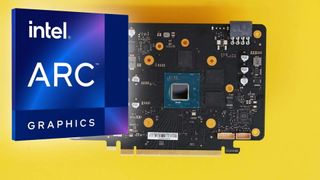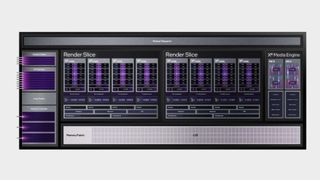Intel's official Arc A380 gaming benchmarks confirm it's on average 15% slower than a 3 year-old GPU
The Arc A380 reviewer's guide lists 17 different games against Nvidia's GTX 1650 and AMD's RX 6400.

Intel's first discrete graphics card, the Arc A380, has been released. In China, exclusively. That's a bit of a shame, but it has at least allowed Intel to stick to its aim of getting the discrete Arc GPUs released early this year. Even if it is just in a single region, and only via OEMs right now.
The first benchmarks of Intel's mainstream card came out with the first reviews out of China, but now Intel has provided us with its reviewer's guide containing far more benchmark numbers across a swathe of games. Though it has to be said, you've always got to take 'official' benchmark results with a pinch of salt as they are generally going to be carried out under optimum conditions, which can sometimes skew the results.
That doesn't actually look to be the case here, as the numbers from Intel itself seem to match up pretty well when it's testing the same games as the Chinese reviewers. In short, that confirms the fact the Arc A380 is behind both the Nvidia GTX 1650 and AMD RX 6400 when it comes to gaming performance.
Considering the GTX 1650 is a three-year-old mainstream GPU now—and wasn't considered that quick a card even back at launch—the fact that Intel's kicked off its first real foray into the discrete gaming GPU market with the A380 still looks kinda odd.
It's worth noting that the results Intel is offering up are the scores for its reference card, which is the 75W TBP option. That means it doesn't have a PCIe power connector on the board and draws all its power from the motherboard slot it's plugged into. This limits it to a 2,000MHz clock speed, where AIBs can choose to add a 6 or 8-pin PCIe power connector to their boards and offer either 80W or 87W versions with 2,250MHz and 2,350MHz clock speeds respectively.
The previous review results came from the Gunnir Arc A380 which does have an 8-pin power connector, however, so I wouldn't expect too much in the way of a performance uplift even at the 2,350MHz level.

















CPU: Intel Core i5 12600K
Motherboard: MSI Pro Z690-A WiFi DDR4
Memory: 32GB (2x 16GB) DDR4-3200
Storage: 4TB Corsair MP600 Pro XT
OS: Windows 11 Version 10.0.22000.675
There are some cases in the benchmarks where Intel's card actually does come out on top, such as in Naraka Bladepoint, Total War: Troy, and F1 2021. But most games have the A380 being beaten by AMD and Nvidia's mainstream cards.
The biggest gaming news, reviews and hardware deals
Keep up to date with the most important stories and the best deals, as picked by the PC Gamer team.
Averaging out the percentage difference across the benchmarks, however, does show that over those 17 games, the Arc A380 is on average 15% slower than the GTX 1650 but only 8% slower than the RX 6400.
Of course, that's a simple averaging of results, with the worst case against the GTX 1650 sees the A380 27% slower in Wolfenstein Youngblood and 23% slower than the RX 6400 in Battlefield V.
Interestingly, Intel hasn't included any synthetic 3DMark numbers in its official benchmarks. Given the stellar performance shown in the independent reviews, that seems strange. Especially given those results have the Arc A380 delivering an index score almost 43% higher than the GTX 1650. And even beats the RX 6500 XT by a shade.

This makes me think there is still the potential for some latent performance to be squeezed out of Intel's Xe cores that its driver software hasn't yet been able to surface in games. That's compounded by the fact that the A380 is capable of between 4 and 4.8 TFLOPS (depending on clock speed) of single precision FP32 processing, while the GTX 1650 is rated at a little under 3 TFLOPS.
Now, I know that FP32 TFLOPS are not in any way a precise way to measure subsequent gaming performance, but it might suggest there is more to come from Intel's Arc GPUs, and potentially that's why they're still yet to make an appearance globally.
Or in a form that might actually make an impact on the gaming GPU market.
Best CPU for gaming: Top chips from Intel and AMD
Best gaming motherboard: The right boards
Best graphics card: Your perfect pixel-pusher awaits Best SSD for gaming: Get into the game first

Dave has been gaming since the days of Zaxxon and Lady Bug on the Colecovision, and code books for the Commodore Vic 20 (Death Race 2000!). He built his first gaming PC at the tender age of 16, and finally finished bug-fixing the Cyrix-based system around a year later. When he dropped it out of the window. He first started writing for Official PlayStation Magazine and Xbox World many decades ago, then moved onto PC Format full-time, then PC Gamer, TechRadar, and T3 among others. Now he's back, writing about the nightmarish graphics card market, CPUs with more cores than sense, gaming laptops hotter than the sun, and SSDs more capacious than a Cybertruck.
Most Popular






